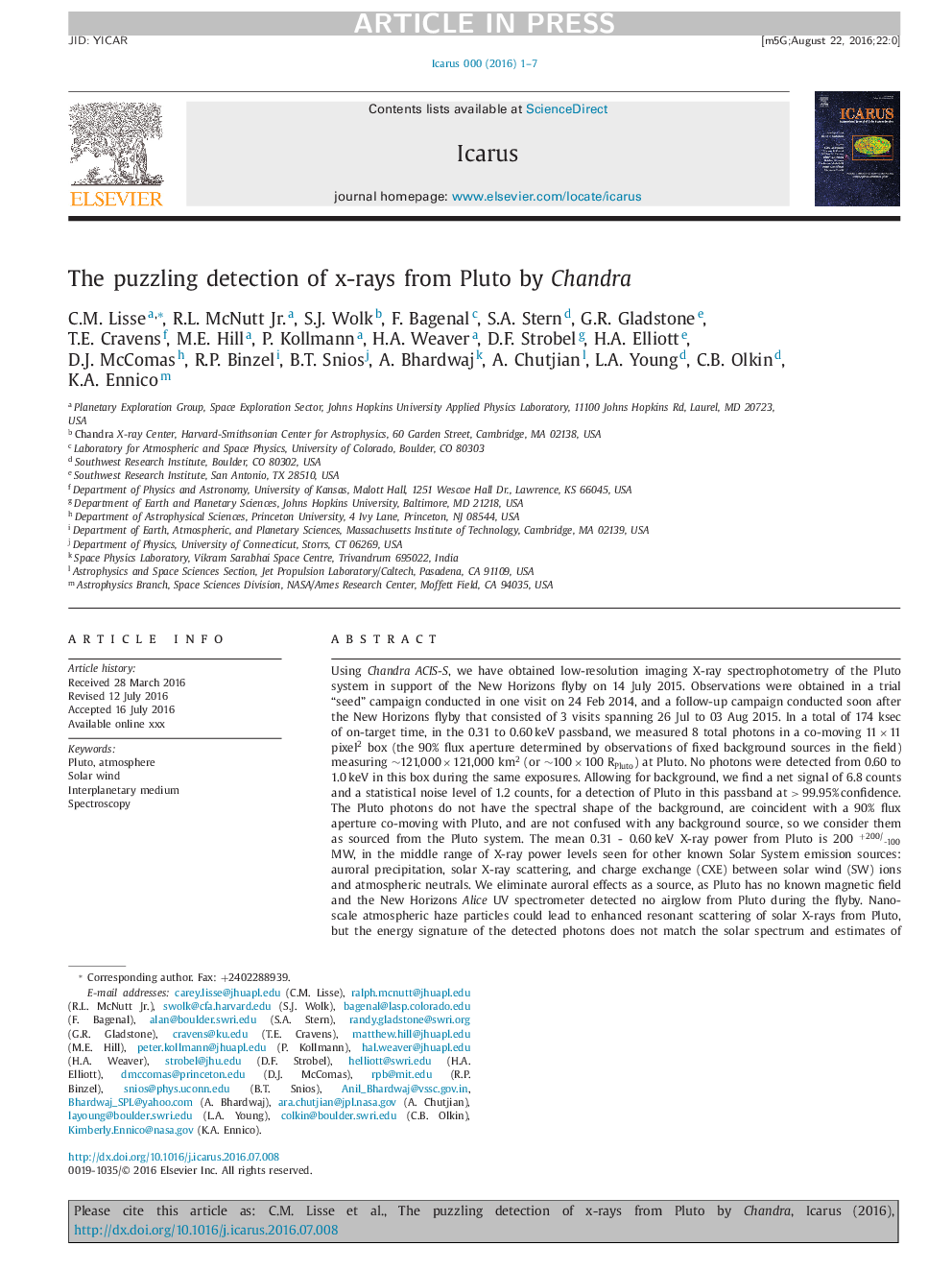| کد مقاله | کد نشریه | سال انتشار | مقاله انگلیسی | نسخه تمام متن |
|---|---|---|---|---|
| 5487358 | 1523504 | 2017 | 7 صفحه PDF | دانلود رایگان |
عنوان انگلیسی مقاله ISI
The puzzling detection of x-rays from Pluto by Chandra
ترجمه فارسی عنوان
تشخیص غم انگیز اشعه ایکس از پلوتو توسط چاندرا
دانلود مقاله + سفارش ترجمه
دانلود مقاله ISI انگلیسی
رایگان برای ایرانیان
کلمات کلیدی
پلوتو، فضا، باد خورشیدی، محیط بین سیاره ای، طیف سنجی،
موضوعات مرتبط
مهندسی و علوم پایه
علوم زمین و سیارات
علوم فضا و نجوم
چکیده انگلیسی
Using Chandra ACIS-S, we have obtained low-resolution imaging X-ray spectrophotometry of the Pluto system in support of the New Horizons flyby on 14 July 2015. Observations were obtained in a trial “seed” campaign conducted in one visit on 24 Feb 2014, and a follow-up campaign conducted soon after the New Horizons flyby that consisted of 3 visits spanning 26 Jul to 03 Aug 2015. In a total of 174 ksec of on-target time, in the 0.31 to 0.60 keV passband, we measured 8 total photons in a co-moving 11 Ã 11 pixel2 box (the 90% flux aperture determined by observations of fixed background sources in the field) measuring â¼121,000 Ã 121,000 km2 (or â¼100 Ã 100 RPluto) at Pluto. No photons were detected from 0.60 to 1.0 keV in this box during the same exposures. Allowing for background, we find a net signal of 6.8 counts and a statistical noise level of 1.2 counts, for a detection of Pluto in this passband at > 99.95% confidence. The Pluto photons do not have the spectral shape of the background, are coincident with a 90% flux aperture co-moving with Pluto, and are not confused with any background source, so we consider them as sourced from the Pluto system. The mean 0.31 - 0.60 keV X-ray power from Pluto is 200 +200/-100 MW, in the middle range of X-ray power levels seen for other known Solar System emission sources: auroral precipitation, solar X-ray scattering, and charge exchange (CXE) between solar wind (SW) ions and atmospheric neutrals. We eliminate auroral effects as a source, as Pluto has no known magnetic field and the New Horizons Alice UV spectrometer detected no airglow from Pluto during the flyby. Nano-scale atmospheric haze particles could lead to enhanced resonant scattering of solar X-rays from Pluto, but the energy signature of the detected photons does not match the solar spectrum and estimates of Pluto's scattered X-ray emission are 2 to 3 orders of magnitude below the 3.9 ± 0.7 Ã 10â5 cps found in our observations. Charge-exchange-driven emission from hydrogenic and heliogenic SW carbon, nitrogen, and oxygen (CNO) ions can produce the energy signature seen, and the 6 Ã 1025 neutral gas escape rate from Pluto deduced from New Horizons' data (Gladstone et al. 2016) can support the â¼3.0 +3.0/-1.5 à 1024 X-ray photons/s emission rate required by our observations. Using the solar wind proton density and speed measured by the Solar Wind Around Pluto (SWAP) instrument in the vicinity of Pluto at the time of the photon emissions, we find a factor of 40 +40/-20 lower SW minor ions flowing planarly into an 11 Ã 11 pixel2, 90% flux box centered on Pluto than are needed to support the observed emission rate. Hence, the SW must be somehow significantly focused and enhanced within 60,000 km (projected) of Pluto for this mechanism to work.
ناشر
Database: Elsevier - ScienceDirect (ساینس دایرکت)
Journal: Icarus - Volume 287, 1 May 2017, Pages 103-109
Journal: Icarus - Volume 287, 1 May 2017, Pages 103-109
نویسندگان
C.M. Lisse, R.L. Jr., S.J. Wolk, F. Bagenal, S.A. Stern, G.R. Gladstone, T.E. Cravens, M.E. Hill, P. Kollmann, H.A. Weaver, D.F. Strobel, H.A. Elliott, D.J. McComas, R.P. Binzel, B.T. Snios, A. Bhardwaj, A. Chutjian, L.A. Young, K.A. Ennico,
